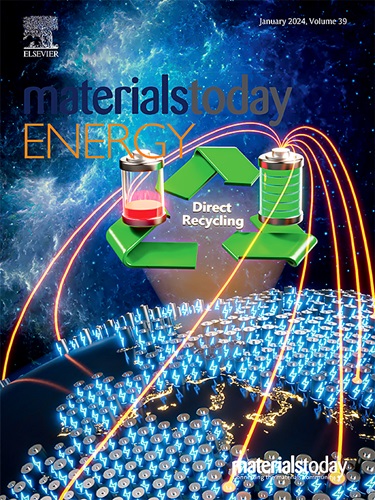原位构建 RuS2 纳米晶体装饰的无定形 NiSx 纳米片,用于工业电流密度的水分离
IF 8.6
2区 材料科学
Q1 CHEMISTRY, PHYSICAL
引用次数: 0
摘要
开发能以工业电流密度运行的水分离电催化剂对于大规模制氢至关重要。本文设计了一种简便的湿化学策略和可扩展的原位硫化技术,用于在镍泡沫(NF)上垂直排列形成 RuS 纳米晶装饰的无定形 NiS 纳米片(RuNiS/NF),作为电化学水分离(EWS)的超高效电催化剂。优化后的电催化剂表现出优异的氢进化反应(HER)性能,在 10、100 和 1000 mA/cm 下的过电位分别仅为 15、50 和 114 mV,并且在 10、100 和 500 mA/cm 下可稳定运行 120 小时,是工业用水电解的高效电催化剂之一。异质界面上的电子再分布诱导了异质结构的调制电子态,从而导致了对反应中间产物的有利吸附行为,提高了活性位点的内在活性。令人印象深刻的是,RuNiS/NF||RuNiS/NF EWS 器件在电压为 1.55、1.77 和 2.35 V 时的工业电流密度分别为 10、100 和 500 mA/cm,而且耐用性超过 50 h(@1000 mA/cm)。这项工作提供了一种创新方法,通过调制电子状态为工业 EWS 设计独特的异质结构。本文章由计算机程序翻译,如有差异,请以英文原文为准。

In-situ construction of RuS2 nanocrystal-decorated amorphous NiSx nanosheets for industrial-current-density water splitting
Developing enabling electrocatalysts for water splitting to operate at industrial-current-density is crucial for large-scale hydrogen production. Herein, a facile wet-chemistry strategy and scalable in-situ sulfidation technique are designed for formation of RuS nanocrystal-decorated amorphous NiS nanosheets vertically aligned on Ni foam (NF) (RuNiS/NF) as ultra-highly efficient electrocatalysts for electrochemical water splitting (EWS). The optimized electrocatalyst exhibits an excellent hydrogen evolution reaction (HER) performance, requiring overpotentials of only 15, 50, and 114 mV at 10, 100, and 1000 mA/cm, respectively, with robust stability at 10, 100, and 500 mA/cm for 120 h, ranking it one of the efficient electrocatalysts for industrial water electrolysis. The electron redistribution over heterointerfaces induces the modulatory electronic states of heterostructures, thus leading to the favorable adsorption behavior for reaction intermediates, enhancing intrinsic activity of active sites. Impressively, a RuNiS/NF||RuNiS/NF EWS device can afford industrial current densities of 10, 100, and 500 mA/cm at voltages of 1.55, 1.77, and 2.35 V, respectively, together with robust durability for over 50 h (@1000 mA/cm). This work provides an innovative approach to design unique heterostructures for industrial EWS via modulatory electronic states.
求助全文
通过发布文献求助,成功后即可免费获取论文全文。
去求助
来源期刊

Materials Today Energy
Materials Science-Materials Science (miscellaneous)
CiteScore
15.10
自引率
7.50%
发文量
291
审稿时长
15 days
期刊介绍:
Materials Today Energy is a multi-disciplinary, rapid-publication journal focused on all aspects of materials for energy.
Materials Today Energy provides a forum for the discussion of high quality research that is helping define the inclusive, growing field of energy materials.
Part of the Materials Today family, Materials Today Energy offers authors rigorous peer review, rapid decisions, and high visibility. The editors welcome comprehensive articles, short communications and reviews on both theoretical and experimental work in relation to energy harvesting, conversion, storage and distribution, on topics including but not limited to:
-Solar energy conversion
-Hydrogen generation
-Photocatalysis
-Thermoelectric materials and devices
-Materials for nuclear energy applications
-Materials for Energy Storage
-Environment protection
-Sustainable and green materials
 求助内容:
求助内容: 应助结果提醒方式:
应助结果提醒方式:


